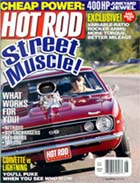

HOW TO DOUBLE YOUR TRANSMISSION
Photography: Steve Magnante
Reprint from HOT ROD Magazine, May 2000
Forget everything you think you know about bolt-on overdrive units. The Gear Vendors under/overdrive system basically rewrites that book. The concept of overdrive has always been closely linked with penny pinching and maximized fuel economy through a reduction in the overall final drive ratio, but until recently, few viewed it as the perfect performance enhancement.
The Gear Vendors (GV) under/overdrive unit is unique in that it bolts to an existing manual or automatic transmission with a sturdy aluminum adapter that replaces the stock extension housing. Thanks to the unique gear-splitting capability of its reaction planetary system, it doubles the number of pre-existing forward gear ranges with the flick of a switch, while greatly improving vehicle response at any throttle position from idle to WFO. When better fuel economy is desired, the 0.78:1 ratio slows engine speed by 22 percent, thus reducing those wild 4.56:1 dragstrip gears to a freeway-friendly 3.55:1 ratio (when fitted to a transmission with a 1:1 top gear ratio). Super economical double-overdrive is possible when the GV unit is added to any transmission with an overdriven high gear. For example, a GM 700-R4/ 4L60E type transmission’s 0.70 OD ratio becomes 0.55:1 when the GV is activated. In double-overdrive, 4.88s will feel like 2.67s to both you and your engine.
We recently drove two such kindly vehicles and were convinced that for sheer bang for the buck, gear-splitting is on par with the addition of a nitrous kit for its ability to transform. While a GV setup will set you back $2,200, the savings in fuel and the satisfaction of enhanced performance will eventually outweigh the investment. Gear Vendors is so confident in its product that all units come with a two-year unlimited horsepower warranty and a 30-day 100 percent buy-back policy.
What is Gear Splitting?
Because Detroit transmission designers are under tremendous pressure to contain manufacturing costs, production-based gearboxes are rife with compromises that limit performance as well as
economy. The greatest of them is the limited number of forward gear ratios (including overdrive). Performance suffers when the rpm drop caused by each upshift reduces the mechanical advantage available to the engine, and the rate of acceleration suffers until the engine regains enough crankshaft speed to put it closer to its power peak.
In a perfect world, a specific transmission would complement the operating characteristics of each engine. If a particular engine made maximum power at 8,000 rpm, then it would be mated to a transmission with as many forward ratios as necessary to stay within the peak power range. The ratios would be tailored, and there would be so many gears with so little spread between each one, crank speed would barely be affected, thus allowing the engine optimized performance and economy. But in our imperfect world, this will never happen, so we end up with a situation where one basic transmission is used behind a wide variety of engines-with varying degrees of success.
Gear Vendors seems to have the cure, offering an extremely compact yet bullet-proof (to 1,200hp) bolt-on under/overdrive unit that can be activated in any forward range with the effect of reducing the rpm drop during upshifts by roughly 50 percent-a significant gain in performance without laying a hand on the engine. To understand this, you must realize that gears are torque multipliers that offer the engine mechanical advantage as they move the car through a wide range of speeds and load conditions. The smaller the gap between the gears, the more effectively the output can be utilized.
In the case of GM Performance Parts LT4 350 crate motor (PN 12371172), maximum output is 335 hp at 6,300 rpm and 346 lb-ft of torque at 3,730 rpm. A theoretical testbed uses a stock TH400 in a 3,400-pound Nova with 3.55:1 gears; the spacing between the 2.48:1 First gear and the 1.48:1 Second gear should result in a drop of approximately 2,000 rpm under full
throttle, reducing engine speed to an output of 260 hp. Activating the GV unit at the top of First gear instead of shifting into Second puts the transmission in First/Over. In this mode, the effective transmission ratio is a happy 1.93:1 that drops engine speed 1,000 rpm from its power peak (right where the LT4 makes 300 hp). Once the engine reaches maximum rpm in First/Over, the transmission can be shifted into Second, then into Second/Over, then Drive, then Drive/Over. All the while, the motor stays closer to its peak power plateau, and acceleration is maximized. In fact, this additional shifting is pleasing to most drivers who enjoy a firm, crisp upshift, and it’s as simple as pushing a button.
Moving the selector switch from the manual to the automatic setting (Auto-drive), the GV microprocessor will only activate Overdrive after the transmission has shifted into high gear at cruising speed. Once this occurs, engine rpm drops 22 percent (when coupled to a transmission with 1:1 high gear, factory overdrive transmission will further reduce engine rpm) and the number of crankshaft revolutions previously required to travel 500 miles will now carry you 640 miles. At this rate, fuel savings accumulate rather quickly, not to mention the boost in engine life.
The Gear Vendors unit also offers a viable alternative to swapping in a modern O/D replacement. Let’s say you replace that stout TH400 with a 700-R3. Well, you now have a 0.70 overdrive ratio, but the 3.09:1 First gear makes it the widest ratio RWD four-speed automatic transmission of the planet. As we have stated, those wide ratios cause severe rpm drops during upshifts and compromise your car’s ability to accelerate quickly. Couple that to the 700-R4’s marginal strength, and it becomes clear that adding a Gear Vendors to your bullet proof TH400 is the better way to go. Besides, who wants three forward speeds when you can have six?


The control panel is equipped with a rocker switch that can be toggled between manual and automatic modes. In the manual mode, you control the engagement of the under/overdrive with the standard foot-operated switch (similar to a headlight dimmer) or an optional B&M shift handle with a military-spec detent switch. A green indicator light illuminates when the transmission is in Overdrive. Then the overdrive automatically engages, and engine rpm drops approximately 22 percent in relation to driveshaft speed. For those with no fear of radar, the reciprocal is a 28 percent increase in road speed at the same engine speed.

The control panel comes with a mounting bracket and Velcro, or a special flush-mount panel can be specified.
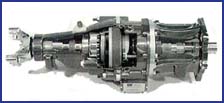
Inner workings of the GV unit (shown with TH400 adapter attached) are revealed here. The Overdrive gears are epicyclic and consist of a central sun gear meshing with three planet gears (encased in a planetary carrier) which in turn mesh with an internally toothed (annulus) ring gear. When overdrive is inactive, all gears are static. The planet carrier is attached to the input shaft, and the annulus is integral with the output shaft. The transmission main shaft is mated to the overdrive input shaft by means of a coupler (included with kit). In direct drive, power is transmitted from the input shaft to the inner member of a uni-directional clutch and then to the outer member of the clutch assembly (caged rollers). The rollers are driven up the inclined faces of the inner member and wedged between the clutch assembly and the annulus, which is integral with the output shaft. The planetary gears are inoperative, and power is transmitted directly from the transmission through the GV unit to the driveshaft at a 1:1 ratio. A cone clutch is mounted on the externally splined extension of the sun gear and is loaded onto the annulus by four springs, which react against the casing of the overdrive unit. The spring load is transmitted to the clutch through a thrust ring and ball bearing. This causes the inner friction lining of the cone clutch to contact the outer race of the cone of the annulus and rotate 1 to 1 with the annulus while the springs and thrust ring remain stationary against it. Since the sun gear is splined to the cone clutch, the planetary gear assembly is locked, permitting overdrive and reverse torque to be transmitted. Additional load is imparted to the clutch, during reverse, by the sun gear, which, due to the helix angle of its gear teeth, thrusts rearward and reacts against the cone clutch. Simple, right?

Surprisingly compact dimensions of the unit are demonstrated here. To “test fit” one to the driveshaft tunnel, use a 2-pound coffee can as visual aid. Position the can an inch from the end of the stock transmission-that’s where the under/overdrive unit and tailshaft adapter will be located. Most American cars will accept the unit without modification, and any floorboard reworking is usually limited to small indentations to clear a structural boss on the case (arrow).

There is no need to change the speedometer cable when doing the Gear Vendors upgrade. A special adapter and speedometer cable shunt are standard equipment.
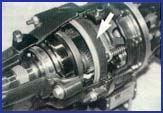
A close-up shows the Raybestos-lined sliding cone clutch (arrow). During overdrive, the cone clutch is no longer in contact with the annulus but has moved forward so its outer friction lining is in contact with a brake ring, which is part of the overdrive casing. Because the cone clutch is held stationary, the sun gear (to which the cone clutch is attached) is also held stationary. The planet carrier rotates with the input shaft, thus causing the planet gears to rotate about their own axes and drive the annulus/output shaft at a faster speed than the input shaft (overdrive). The uni-directional clutch allows this, since the outer member can overrun the inner member. Forward movement of the cone clutch is accomplished by means of hydraulic pressure that acts on two pistons when a valve (the solenoid) is opened by the driver-controlled selector switch. This hydraulic pressure overcomes the springs and moves the cone clutch forward against the brake ring with sufficient load to hold the sun gear at rest. Additional load is again imparted to the clutch in a forward direction due to the helix angle of the gear teeth. Though the standard power rating is 1,200hp, special-order units accommodate as much as 2,000. The GV’s highly efficient operating characteristics require but 1 horsepower for every 400 hp passed through it.

Hydraulic pressure is developed by a plunger-type pump that is cam-activated from the input shaft (see pointer). The pump draws oil from an air-cooled sump through a suction filter and delivers it via a one-way valve through a pressure filter to the operating solenoid valve and relief valve. A spring dashpot that ensures smooth (yet firm) overdrive engagement and disengagement under varying conditions is incorporated in the relief valve. In direct drive (OD disengaged), a residual pressure of 20-40 psi is maintained within the system. When the overdrive is engaged, this level is gradually increased to full operating pressure.
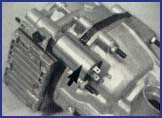
When the solenoid is energized (arrow), its valve opens and directs the oil (which is at residual pressure) to the bottom of an internal dashpot piston. This causes the dashpot piston to rise and affect a gradual increase in hydraulic pressure until the piston reaches its stop. By this time, the relief valve has been compressed and is supplying full operating pressure (650-700 psi) to enable the application of the cone clutch and the subsequent engagement of overdrive.


All GV under/overdrives include a rugged 1350-series yoke, regardless of transmission or vehicle type. To accommodate the extra length of the overdrive unit, have a shop reconfigure your driveshaft to accept a 1350 universal joint while they are shortening it. Weld yokes for the 1350 U-joint are commonly available for an assortment of tube diameters.
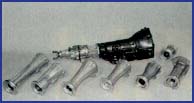
Specific extension adapters mate the unit to most popular transmissions. From L to R: Chrysler 727 (long), 727 (short), Ford C6, C4, GM Powerglide, TH350, and Ford/Jerico top loader. The GM TH400 in the background shows how the extension adapter positions the GV unit. Adapters for the 700-R4/4L60E, 4L80E, E4OD/4R100, and plenty more are also available, and each is designed to accept the stock transmission mount and crossmember. While the correct adapter for your application is included at no charge, it is possible to swap the Gear Vendors unit to a different car with no change other than an adapter kit (about $400). Custom adapters are also available for one-off or obsolete applications. East Coast Rolls Royce restoration shop (Sports Classics, Brookfield, Massachusetts) collaborated with GV on a custom adapter and purchases Gear Vendors units for installation in its customers’ million-dollar show cars. The breech of originality is outweighed by the vast improvement in driveability.
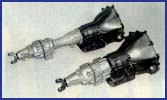
The 0.78:1 high-gear ratio allows numerically higher rear axle gears for improved 60-foot times. A car with 4.56:1 gears could go to 5.84s without diminishing top end speed or increasing engine rpm at the finish line thanks to the 1.28 reciprocal value of the 0.78 overdrive. Shown are a standard length Powerglide installation and a special shorty kit that is ideal for rear engine dragsters and cars with extreme engine set back. Shorty kits incorporate 4WD output shaft components and reduce overall length 10 to 14 inches.

Street rods and the big Ford F350 Power Stroke diesel 4×4 truck share one thing in common: a Gear Vendors under/over drive unit. Addition of a deep oil sump on the truck unit (arrow, below left) adds more fluid capacity for a 30,000-pound gross vehicle weight. If used properly and well maintained, the overdrive has proven to be capable of hundreds of thousands of miles.

Needless to say, there is no questioning its capability behind a rod rodded V-8. Just ask former HRM Tech Editor Cole Quinnell. He drove Pavement Pounder, and 890hp ’57 Chevy from Los Angeles to Mt. Clemens, Michigan, on Power Tour ’98, his Gear Vendors under/overdrive unit loving every mile of it while returning a steady 9 mpg (versus 6 mph without overdrive).